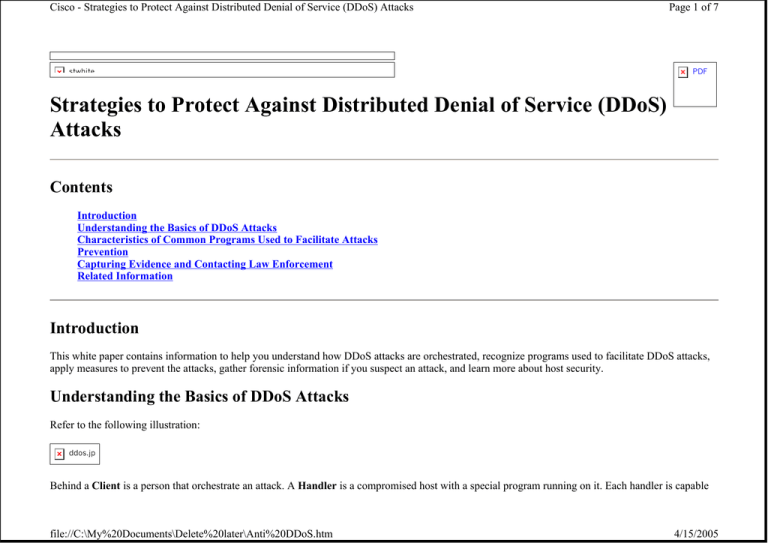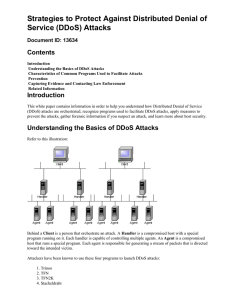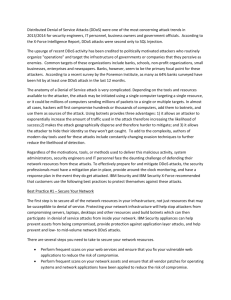Strategies to Protect Against Distributed Denial of Service (DDoS) Attacks Contents
advertisement

Cisco - Strategies to Protect Against Distributed Denial of Service (DDoS) Attacks
stwhite
Page 1 of 7
PDF
Strategies to Protect Against Distributed Denial of Service (DDoS)
Attacks
Contents
Introduction
Understanding the Basics of DDoS Attacks
Characteristics of Common Programs Used to Facilitate Attacks
Prevention
Capturing Evidence and Contacting Law Enforcement
Related Information
Introduction
This white paper contains information to help you understand how DDoS attacks are orchestrated, recognize programs used to facilitate DDoS attacks,
apply measures to prevent the attacks, gather forensic information if you suspect an attack, and learn more about host security.
Understanding the Basics of DDoS Attacks
Refer to the following illustration:
ddos.jp
Behind a Client is a person that orchestrate an attack. A Handler is a compromised host with a special program running on it. Each handler is capable
file://C:\My%20Documents\Delete%20later\Anti%20DDoS.htm
4/15/2005
Cisco - Strategies to Protect Against Distributed Denial of Service (DDoS) Attacks
Page 2 of 7
of controlling multiple agents. An Agent is a compromised host that is running a special program. Each agent is responsible for generating a stream of
packets that is directed toward the intended victim.
Attackers have been known to use the following 4 programs to launch DDoS attacks: Trinoo, TFN, TFN2K and Stacheldraht.
In order to facilitate DDoS, the attackers need to have several hundred to several thousand compromised hosts. The hosts are usually Linux and SUN
computers; however, the tools can be ported to other platforms as well. The process of compromising a host and installing the tool is automated. The
process can be divided into the following steps, in which the attackers:
1. Initiate a scan phase in which a large number of hosts (on the order of 100,000 or more) are probed for a known vulnerability.
2. Compromise the vulnerable hosts to gain access.
3. Install the tool on each host.
4. Use the compromised hosts for further scanning and compromises.
Because an automated process is used, attackers can compromise and install the tool on a single host in under 5 seconds. In other words, several
thousand hosts can be compromised in under an hour.
Characteristics of Common Programs Used to Facilitate Attacks
The following are common programs that hackers use to facilitate distributed denial of services attacks:
z
Trinoo
Communication between clients, handlers and agents use the following ports:
1524 tcp
27665 tcp
27444 udp
31335 udp
Note: The ports listed above are the default ports for this tool. Use these ports for orientation and example only, because the port numbers can
easily be changed.
file://C:\My%20Documents\Delete%20later\Anti%20DDoS.htm
4/15/2005
Cisco - Strategies to Protect Against Distributed Denial of Service (DDoS) Attacks
z
Page 3 of 7
TFN
Communication between clients, handlers and agents use ICMP ECHO and ICMP ECHO REPLY packets.
z
Stacheldraht
Communication between clients, handlers and agents use the following ports:
16660 tcp
65000 tcp
ICMP ECHO
ICMP ECHO REPLY
Note: The ports listed above are the default ports for this tool. Use these ports for orientation and example only, because the port numbers can
easily be changed.
z
TFN2K
Communication between clients, handlers and agents does not use any specific port (it may be supplied on run time or it will be chosen randomly
by a program) but is a combination of UDP, ICMP and TCP packets.
For a detailed analysis of DDoS programs, read the following articles.
Note: The following links point to external web sites not maintained by Cisco Systems
The DoS Project's "trinoo" distributed denial of service attack tool
The "Tribe Flood Network" distributed denial of service attack tool
The "stacheldraht" distributed denial of service attack tool
Additional information regarding DDoS tools and their variants can be found at the Packet Storm web site's Index of Distributed Attack Tools
.
Prevention
file://C:\My%20Documents\Delete%20later\Anti%20DDoS.htm
4/15/2005
Cisco - Strategies to Protect Against Distributed Denial of Service (DDoS) Attacks
Page 4 of 7
The following are suggested methods to prevent distributed denial of service attacks.
1. Use the ip verify unicast reverse-path interface command on the input interface on the router at the upstream end of the connection.
This feature examines each packet received as input on that interface. If the source IP address does not have a route in the CEF tables that points
back to the same interface on which the packet arrived, the router drops the packet.
The effect of Unicast RPF is that it stops SMURF attacks (and other attacks that depend on source IP address spoofing) at the ISP's POP (lease
and dial-up). This protects your network and customers, as well as the rest of the Internet. To use unicast RPF, enable "CEF switching" or "CEF
distributed switching" in the router. There is no need to configure the input interface for CEF switching. As long as CEF is running on the router,
individual interfaces can be configured with other switching modes. RPF is an input side function that enabled on an interface or sub-interface
and operates on packets received by the router.
It is very important for CEF to be turned on in the router. RPF will not work without CEF. Unicast RPF is not supported in any 11.2 or 11.3
images. Unicast RPF is included in 12.0 on platforms that support CEF, including the AS5800. Hence, unicast RFP can be configured on the
PSTN/ISDN dial-up interfaces on the AS5800.
2. Filter all RFC1918 address space using access control lists.
Refer to the following example:
interface xy
ip access-group
access-list 101
access-list 101
access-list 101
access-list 101
101 in
deny ip 10.0.0.0
0.255.255.255 any
deny ip 192.168.0.0 0.0.255.255 any
deny ip 172.16.0.0 0.15.255.255 any
permit ip any any
3. Apply ingress and egress filtering (see RFC 2267) using ACL.
Refer to the following example:
{ ISP Core } -- ISP Edge Router -- Customer Edge Router -- { Customer network }
The ISP edge router should only accept traffic with source addresses belonging to the customer network. The customer network should only
accept traffic with source addresses other than the customer network block. The following is a sample ACL for an ISP edge router:
file://C:\My%20Documents\Delete%20later\Anti%20DDoS.htm
4/15/2005
Cisco - Strategies to Protect Against Distributed Denial of Service (DDoS) Attacks
Page 5 of 7
access-list 190 permit ip {customer network} {customer network mask} any
access-list 190 deny ip any any [log]
interface {ingress interface} {interface #}
ip access-group 190 in
The following is a sample ACL for a customer edge router:
access-list 187 deny ip {customer network} {customer network mask} any
access-list 187 permit ip any any
access-list 188 permit ip {customer network} {customer network mask} any
access-list 188 deny ip any any
interface {egress interface} {interface #}
ip access-group 187 in
ip access-group 188 out
If you are able to turn on Cisco Express Forwarding (CEF), the length on the ACLs can be substantially reduced and thus increase performance
by enabling unicast reverse path forwarding. In order to support unicast reverse path forwarding, you only need to be able to enable CEF on the
router as a whole; the interface on which the feature is enabled does not need to be a CEF switched interface.
4. Use CAR to rate limit ICMP packets.
Refer to the following example:
interface xy
rate-limit output access-group 2020 3000000 512000 786000 conform-action
transmit exceed-action drop
access-list 2020 permit icmp any any echo-reply
For more information, refer to IOS Essential Features.
5. Configure rate limiting for SYN packets.
Refer to the following example:
file://C:\My%20Documents\Delete%20later\Anti%20DDoS.htm
4/15/2005
Cisco - Strategies to Protect Against Distributed Denial of Service (DDoS) Attacks
Page 6 of 7
interface {int}
rate-limit output access-group 153 45000000
100000 100000 conform-action
transmit exceed-action drop
rate-limit output access-group 152 1000000 100000
100000 conform-action
transmit exceed-action drop
access-list 152 permit tcp any host eq www
access-list 153 permit tcp any host eq www
established
In the above example, replace:
{
45000000 with the maximum link bandwidth
{
1000000 with a value that is between 50% and 30% of the SYN flood rate
{
burst normal and burst max rates with accurate values
Note that if you set the burst rate greater than 30%, many legitimate SYNs may be dropped. To get an idea of where to set the burst rate, use the
show interfaces rate-limit command to display the conformed and exceeded rates for the interface. Your objective is to rate-limit the SYNs as
little as necessary to get things working again.
warning
Warning: It is recommended that you first measure amount of SYN packets during normal state (before attacks occur) and use those
values to limit. Review the numbers carefully before deploying this measure.
If an SYN attack is aimed against a particular host, consider installing an IP filtering package on that host. One such package is IP Filter
to IP Filter Examples
for implementation details.
. Refer
Capturing Evidence and Contacting Law Enforcement
If possible, capture packet sample for analysis. It is recommended that you use a SUN workstation or a Linux box on a fast Pentium machine to capture
the packet sample. For capturing, use the tcp dump program (Linux or SUN) or snoop (SUN only). The command syntax is:
file://C:\My%20Documents\Delete%20later\Anti%20DDoS.htm
4/15/2005
Cisco - Strategies to Protect Against Distributed Denial of Service (DDoS) Attacks
Page 7 of 7
tcpdump -i interface -s 1500 -w capture_file
snoop -d interface -o capture_file -s 1500
The MTU size in this example is 1500; change this parameter if the MTU is greater than 1500.
Preserve these logs as evidence for law enforcement.
If you want to involve law enforcement and you are within the United States, contact your local FBI field office. More information is available at the
National Infrastructure Protection Center
web site. If you are located in Europe, no single point of contact exists. Contact your local law enforcement
agency and ask for assistance.
CISCO CANNOT CONTACT LAW ENFORCEMENT AGENCIES ON YOUR BEHALF. The Cisco PSIRT team can work with law
enforcement once you have made the initial contacts.
For general host security material, read information provided at the CERT/CC
web page.
Related Information
z
z
z
z
Characterizing and Tracing Packet Floods Using Cisco Routers
Improving Security on Cisco Routers
Cisco Product Security Incident Response
Technical Support - Cisco Systems
Toolbar
All contents are Copyright © 1992-2003 Cisco Systems, Inc. All rights reserved. Important Notices and Privacy Statement.
Updated: Apr 29, 2003
file://C:\My%20Documents\Delete%20later\Anti%20DDoS.htm
Document ID: 13634
4/15/2005



